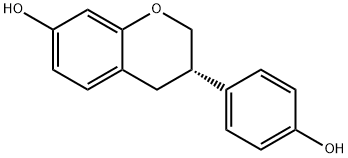94105-90-5
 94105-90-5 结构式
94105-90-5 结构式
基本信息
(+)-雌马酚
R,S-雌马酚
纳米脂质体雌马酚
(卤)-EQUOL
雌马酚,(±)-雌马酚
雌马酚 98% 不是S型,混旋的
3-(4-羟基苯基)四氢苯并吡喃-7-醇
(+/-)Equol
(+/-)-EQUOL
Equol,99%e.e.
EQUOL(RACEMIC)
(+/-)-Equol>
(+/-)-Equol (GMP)
7,4'-HoMoisoflavane
(±)-EQUOL >= 99.0% (TLC)
4′,7-Dihydroxyisoflavane
物理化学性质
制备方法

10499-17-9

531-95-3
在氮气保护下,将化合物3a(0.20 g,0.78 mmol)、n-Bu4NI(1.01 g,2.73 mmol)和无水CH2Cl2(5 mL)的混合物搅拌并冷却至-78℃。随后,向冷却的混合物中逐滴加入BCl3(1 M,2.73 mL,2.73 mmol)的CH2Cl2溶液。将反应混合物搅拌并在2小时内缓慢升温至0℃。反应完成后,用冰水(10 mL)小心淬灭,继续搅拌20分钟,然后用饱和NaHCO3溶液(10 mL)中和。真空浓缩后,用EtOAc(10 mL×0.5)萃取残余物。合并有机层,用无水MgSO4干燥。过滤后,滤液经真空浓缩,通过硅胶柱色谱(乙酸乙酯/正己烷=1:3)纯化,得到无色晶体雌马酚3b(0.18 g,收率95%)。雌马酚的性质如下:熔点162-164℃(文献值158℃);薄层色谱Rf值0.24(乙酸乙酯/正己烷=1:3);红外光谱(KBr)νmax:3231, 2897, 1598, 1510, 1470, 1366, 1252, 1158, 1119, 826 cm-1;1H-NMR(400 MHz, DMSO-d6)δ:2.80(m, 2H, H-3和H-4a),3.01(m, 1H, H-4b),3.89(t, J=10.4 Hz, 1H, H-2a),4.14(d, J=10.4 Hz, 1H, H-2b),6.20(d, J=2.4 Hz, 1H, H-8),6.29(dd, J=8.4, 2.4 Hz, 1H, H-6),6.72(d, J=8.4 Hz, 2H, H-3', H-5'),6.86(d, J=8.4 Hz, 1H, H-5),7.10(d, J=8.4 Hz, 2H, H-2', H-6'),9.18(s, 1H, OH),9.29(s, 1H, OH);13C-NMR(100 MHz, DMSO-d6)δ:31.3, 37.2, 70.3, 102.5, 108.0, 112.6, 115.3, 128.3, 130.1, 131.7, 154.5, 156.2, 156.5;电子轰击质谱(70 eV)m/z(相对强度,百分比):242(M+, 58),135(25),134(40),123(88),120(100),107(39),91(37)。元素分析计算值(C15H14O3):C 74.36,H 5.82;实测值:C 74.13,H 5.90。
参考文献:
[1] Tetrahedron Letters, 2009, vol. 50, # 18, p. 2121 - 2123
[2] Patent: US2010/298581, 2010, A1. Location in patent: Page/Page column 7-8
[3] Bioorganic and Medicinal Chemistry, 2004, vol. 12, # 6, p. 1559 - 1567
常见问题列表
Equol is first isolated and identified from pregnant-mares' urine and later found in the urine of the goat, cow, hen and sheep. Equol, unlike the soy isoflavones daidzein or genistein, has a chiral center and therefore can occur as 2 distinct diastereoisomers. S-equol is the exclusive product of human intestinal bacterial synthesis from soy isoflavones and both enantiomers are bioavailable. S-equol has a high affinity for estrogen receptor beta (K i =0.73 nM), whereas R-equol is relatively inactive. Equol could promote the proliferation and differentiation of rat osteoblasts through activating the ER-PKCα-related signaling pathway. The alkaline phosphatase activity also increases significantly in all of the equol and 17β-estradiol (E2 ) groups. Equol also significantly elevates the osteocalcin levels.
Equol is a modest natriuretic and vasorelaxant agent in the rat. Orally administered equol is about 8-fold less potent than orally administered furosemide. In isolated aortic rings precontracted by administration of phenylephrine, administration of equol relaxes the contracted aorta (concentration for half-maximal activity 58.9±16 μM). Equol possesses anticancer activity that suppresses tumor formation via apoptosis induction in rats with DMBA-induced mammary gland tumors. In addition, equol shows a hepatic protective effect by acting as an antioxidant and by reducing apoptosis.
